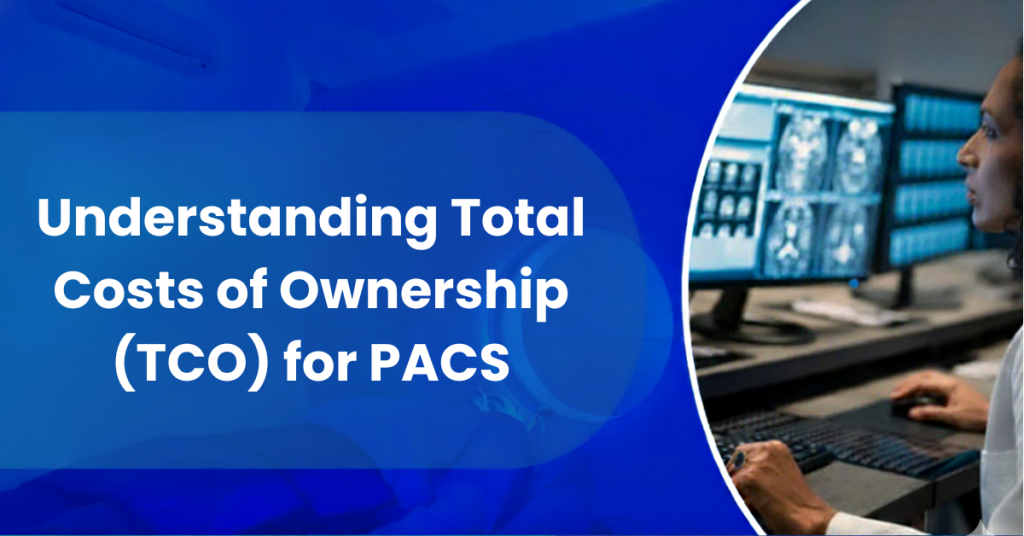In today’s healthcare landscape, technology adoption is no longer a choice but a necessity. One of the most important technologies for modern hospitals and diagnostic centers is the Picture Archiving and Communication System (PACS). PACS allows healthcare providers to store, retrieve, share, and manage medical images digitally, improving efficiency and patient care.
However, investing in PACS requires more than just comparing upfront prices. Healthcare organizations need to evaluate the Total Cost of Ownership (TCO)—a comprehensive calculation that considers not only the initial purchase price but also ongoing expenses, hidden costs, and long-term value. Understanding TCO helps providers make smarter financial decisions and ensure their PACS investment aligns with clinical and operational goals.
The Components of TCO for PACS:-
1. Initial Investment:-
The upfront cost of PACS includes system licenses, servers or cloud subscriptions, and implementation services. While some providers focus only on this cost, it often represents just a fraction of the total investment.
2. Hardware and Infrastructure:-
On-premise PACS requires significant investment in servers, storage systems, and backup solutions. Cloud PACS reduces these expenses by shifting infrastructure management to vendors, but subscription fees must be factored in.
3. Software Licensing and Upgrades:-
Traditional PACS models often involve perpetual licenses with periodic upgrade costs. Cloud-based PACS usually operate on a subscription model, bundling upgrades into ongoing fees, offering predictable expenses.
4. Integration with HIS, RIS, and EMR:-
Seamless integration with existing healthcare systems is critical but can add costs. Custom interfaces, interoperability challenges, and third-party solutions can affect both budget and timelines.
5. Maintenance and Support:-
Ongoing technical support, troubleshooting, and system monitoring represent recurring costs. Cloud PACS often includes these services, while on-premise systems may require dedicated IT staff.
6. Training and Adoption:-
Successful PACS implementation requires training radiologists, clinicians, and administrative staff. These costs, although sometimes overlooked, are vital for maximizing system usage and efficiency.
7. Downtime and Productivity Loss:-
System outages, slow performance, or poor usability can cause costly delays in patient care. Evaluating vendor reliability and system uptime guarantees is essential to minimizing this hidden cost.
8. Scalability and Future Growth:-
As imaging volumes grow, so do storage and performance needs. Cloud PACS solutions offer scalability with predictable costs, whereas on-premise systems often require new hardware investments.
Why TCO is Critical for PACS Decisions?
Many healthcare organizations fall into the trap of choosing the “cheapest” PACS solution without evaluating long-term expenses. A system with low upfront costs may lead to higher expenses down the line due to maintenance, limited scalability, or frequent downtime. Conversely, a slightly higher initial investment in a scalable, cloud-based PACS may yield greater ROI over time.
Understanding TCO ensures:
· Smarter Budgeting – anticipating expenses beyond the purchase price.
· Reduced Financial Risk – avoiding hidden costs that erode value.
· Better ROI Measurement – weighing efficiency gains and patient outcomes against costs.
· Long-Term Planning – selecting a solution that grows with organizational needs.
Strategies to Optimize TCO for PACS:-
1. Conduct a Full Cost Analysis – Include hardware, software, training, support, and hidden costs.
2. Evaluate Vendors Carefully – Choose providers with transparent pricing and strong service-level agreements.
3. Plan for Scalability – Select solutions that can grow with imaging demands without large reinvestments.
4. Prioritize Integration – Ensure seamless interoperability with HIS, RIS, and EMR systems to avoid costly customizations.
5. Leverage Cloud Solutions – For many facilities, cloud PACS reduces infrastructure and maintenance costs while improving accessibility.
Conclusion:-
Understanding the Total Cost of Ownership for PACS is essential for healthcare organizations looking to maximize value and minimize risk. By considering not just the upfront investment but also long-term costs, scalability, and clinical impact, decision-makers can choose the right PACS solution that delivers efficiency, better patient outcomes, and sustainable financial performance.
In an era where healthcare budgets are tight and patient expectations are high, evaluating TCO ensures that PACS investments align with both financial and clinical goals—laying the foundation for future-ready healthcare systems.
